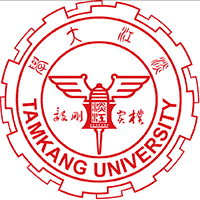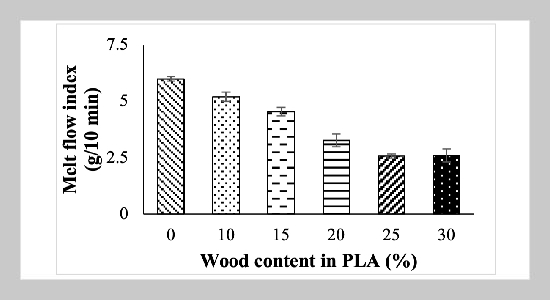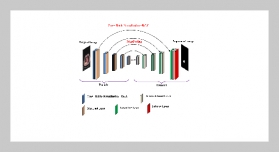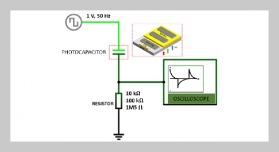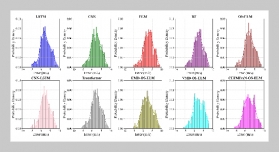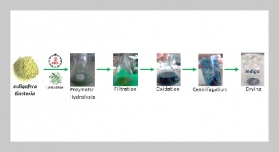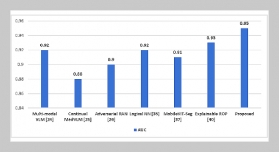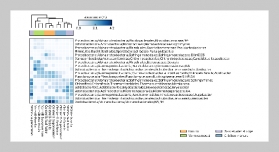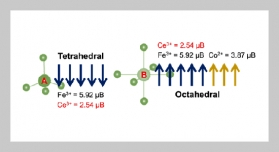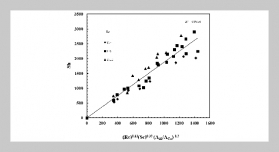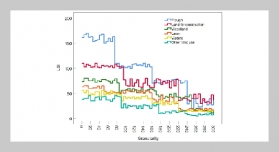- [1] J. R. Dorgan, H. J. Lehermeier, L.-I. Palade, and J. Cicero, (2001) “Polylactides: properties and prospects of an environmentally benign plastic from renewable resources" Macromolecular Symposia 175(1): 55–66. DOI: 10.1002/1521-3900(200110)175:13.0.CO;2-K.
- [2] P. K. Bajpai, I. Singh, and J. Madaan, (2014) “Development and characterization of PLA-based green composites: Areview" Journal of Thermoplastic Composite Materials 27(1): 52–81. DOI: 10.1177/0892705712439571.
- [3] C. Maraveas, (2020) “Production of Sustainable and Biodegradable Polymers from Agricultural Waste" Polymers 12(5): DOI: 10.3390/polym12051127.
- [4] R. Auras, B. Harte, and S. Selke, (2004) “An Overview of Polylactides as Packaging Materials" Macromolecular Bioscience 4(9): 835–864. DOI: https: //doi.org/10.1002/mabi.200400043.
- [5] X. Lu, J. Huang, B. Kang, T. Yuan, and J.-p. Qu, (2019) “Bio-based poly (lactic acid)/high-density polyethylene blends as shape-stabilized phase change material for thermal energy storage applications" Solar Energy Materials and Solar Cells 192: 170–178. DOI: 10.1016/j.solmat.2018.12.036.
- [6] S. Amjadi, S. Emaminia, S. Heyat Davudian, S. Pour mohammad, H. Hamishehkar, and L. Roufegarinejad, (2019) “Preparation and characterization of gelatin based nanocomposite containing chitosan nanofiber and ZnOnanoparticles" Carbohydrate Polymers 216: 376 384. DOI: 10.1016/j.carbpol.2019.03.062.
- [7] M. A. Ortenzi, L. Basilissi, H. Farina, G. Di Silvestro, L. Piergiovanni, and E. Mascheroni, (2015) “Evaluation of crystallinity and gas barrier properties of films obtained from PLA nanocomposites synthesized via “in situ” polymerization of l-lactide with silane-modified nanosilica and montmorillonite" European Polymer Journal 66: 478–491. DOI: 10.1016/j.eurpolymj.2015.03.006.
- [8] C. Vasile, M. Râp˘a, M. ¸Stefan, M. Stan, S. Macavei, R. Darie-Ni¸ t˘ a, L. Barbu-Tudoran, D. Vodnar, E. Popa, R. ¸Stefan, et al., (2017) “New PLA/ZnO: Cu/Ag bio nanocomposites for food packaging." Express Polymer Letters 11(7): DOI: 10.3144/expresspolymlett.2017.51.
- [9] M. Ghozali, S.Fahmiati, E. Triwulandari, W. K. Restu, D. Farhan, M. Wulansari, and W. F. and, (2020) “PLA/metal oxide biocomposites for antimicrobial pack aging application" Polymer-Plastics Technology and Materials 59(12): 1332–1342. DOI: 10.1080/25740881.2020.1738475.
- [10] F. A. Sepúlveda, F. Rivera, C. Loyo, D. Canales, V. Moreno-Serna, R. Benavente, L. M. Rivas, M. T. Ul loa, O. Gil-Castell, A. Ribes-Greus, J. A. Ortiz, and P. A. Zapata, (2022) “Poly (lactic acid)/D-limonene/ZnO bio-nanocomposites with antimicrobial properties" Journal of Applied Polymer Science 139(4): 51542. DOI: https: //doi.org/10.1002/app.51542.
- [11] P. Borysiuk, P. Boruszewski, R. Auriga, L. Danecki, A. Auriga, K. Rybak, and M. Nowacka, (2021) “Influence of a bark-filler on the properties of PLA biocomposites" Journal of Materials Science 56: 9196–9208. DOI: 10. 1007/s10853-021-05901-6.
- [12] S. Ge, S. Zuo, M. Zhang, Y. Luo, R. Yang, Y. Wu, Y. Zhang, J. Li, and C. Xia, (2021) “Utilization of decayed wood for polyvinyl chloride/wood flour composites" Journal of Materials Research and Technology 12: 862 869. DOI: 10.1016/j.jmrt.2021.03.026.
- [13] M. Kaseem, K. Hamad, F. Deri, and Y. G. Ko, (2015) “Material properties of polyethylene/wood composites: A review of recent works" Polymer Science Series A 57: 689–703. DOI: 10.1134/S0965545X15070068.
- [14] R. Várdai, T. Lummerstorfer, C. Pretschuh, M. Jerabek, M. Gahleitner, B. Pukánszky, and K. Renner, (2019) “Impact modification of PP/wood composites: A new approach using hybrid fibers." Express Polymer Letters 13(3): DOI: 10.3144/expresspolymlett.2019.19.
- [15] C. H. Lee, F. N. B. M. Padzil, S. H. Lee, Z. M. A. Ainun, and L. C. Abdullah, (2021) “Potential for Natural Fiber Reinforcement in PLA Polymer Filaments for Fused Depo sition Modeling (FDM) Additive Manufacturing: A Re view" Polymers 13(9): DOI: 10.3390/polym13091407.
- [16] K. A. Adegoke, O. O. Adesina, O. A. Okon-Akan, O. R. Adegoke, A. B. Olabintan, O. A. Ajala, H. Olagoke, N. W. Maxakato, and O. S. Bello, (2022) “Sawdust-biomass based materials for sequestration of organic and inorganic pollutants and potential for engineering applications" Current Research in Green and Sustainable Chemistry 5: 100274. DOI: 10.1016/j.crgsc.2022.100274.
- [17] P. Alizadeh, L. G. Tabil, P. K. Adapa, D. Cree, E. Mupondwa, and B. Emadi, (2022) “Torrefaction and Densification of Wood Sawdust for Bioenergy Applica tions" Fuels 3(1): 152–175. DOI: 10.3390/fuels3010010.
- [18] A. Mohammadi, A. I. Anukam, M. Ojemaye, P. Nya mukamba, and T. Yamada, (2024) “Energy production features of Miscanthus pellets blended with Pine sawdust" BioEnergy Research 17(1): 491–504. DOI: 10.1007/s12155-023-10671-x.
- [19] H. Orelma, A. Tanaka, M. Vuoriluoto, A. Khakalo, and A. Korpela, (2021) “Manufacture of all-wood sawdust-based particle board using ionic liquid-facilitated fusion process" Wood Science and Technology 55: 331–349. DOI: 10.1007/s00226-021-01265-x.
- [20] S. Lv, Y. Huang, Z. Gao, X. Hou, J. Yang, and J. Sun, (2024) “Waste sawdust as a raw material: Synthesis, modification and characterization of novel bio-based phenol formaldehyde wood adhesives" Industrial Crops and Products 219: 119067. DOI: 10.1016/j.indcrop.2024.119067.
- [21] Y. Huang, S. Löschke, and G. Proust, (2021) “In the mix: The effect of wood composition on the 3D printability and mechanical performance of wood-plastic composites" Composites Part C: Open Access 5: 100140. DOI: 10.1016/j.jcomc.2021.100140.
- [22] N. Petchwattana and S. Covavisaruch, (2014) “Me chanical and morphological properties of wood plastic bio composites prepared from toughened poly (lactic acid) and rubber wood sawdust (Hevea brasiliensis)" Journal of Bionic Engineering 11(4): 630–637. DOI: 10.1016/S1672-6529(14)60074-3.
- [23] E. Cuan-Urquizo, A. Álvarez-Trejo, A. Robles Gil, V. Tejada-Ortigoza, C. Camposeco-Negrete, E. Uribe Lam, and C. D. Treviño-Quintanilla, (2022) “Effective Stiffness of Fused Deposition Modeling Infill Lattice Pat terns Made of PLA-Wood Material" Polymers 14(2): DOI: 10.3390/polym14020337.
- [24] Y. Tao, H. Wang, Z. Li, P. Li, and S. Q. Shi, (2017) “De velopment and Application of Wood Flour-Filled Polylac tic Acid Composite Filament for 3D Printing" Materials 10(4): DOI: 10.3390/ma10040339.
- [25] R. M. Allaf and M. Futian, (2020) “Solid-State Com pounding for Recycling of Sawdust Waste into Green Packaging Composites" Processes 8(11): DOI: 10.3390/pr8111386.
- [26] C. Srivabut, S. Rawangwong, S. Hiziroglu, and C. Homkhiew, (2024) “Multi-objective optimization of turning process parameters and wood sawdust contents using response surface methodology for the minimized surface roughness of recycled plastic/wood sawdust composites" Composites Part C: Open Access 14: 100477. DOI: 10.1016/j.jcomc.2024.100477.
- [27] L. Ton-That, T.-N.-L. Huynh, B.-N. Duong, D.-K. Nguyen, N.-A. Nguyen, V.-H. Pham, T.-H. Ho, and V.-P. Dinh, (2023) “Kinetic studies of the removal of methylene blue from aqueous solution by biochar derived from jackfruit peel" Environmental Monitoring and Assessment 195(11): 1266. DOI: 10.1007/s10661-023-11867-6.
- [28] T. Mutiara, I. Rofiki, and M. A. D. Al Ghifari. “Bio adsorbent from modified jackfruit wood sawdust for removal of lead ions”. In: Materials Science Forum. 934. Trans Tech Publ. 2018, 159–164. DOI: 10.4028/www.scientific.net/MSF.934.159.
- [29] P. Minz and S. Mishra, (2023) “Jackfruit peel derived ZnCl2-impregnated activated carbon: optimization, characterization, and application in dye removal" Biomass Conversion and Biorefinery: 1–18. DOI: 10.1007/s13399-023-04592-0.
- [30] A. Chakraborty, J. Panda, A. K. Mishra, S. Sivaku mar, L. V. Srinivasan, A. Nongbet, S. S. Mohanty, S. Rustagi, P. C. Nath, M.S.Wagh,etal.,(2024) “Jackfruit waste for the production of sustainable biorefinery prod ucts: a step towards bio-economic advancement" Biomass Conversion and Biorefinery: 1–23. DOI: 10.1007/s13399-024-05954-y.
- [31] J. Turner, A. Riga, A. O’Connor, J. Zhang, and J. Collis, (2004) “Characterization of drawn and undrawn poly L-lactide films by differential scanning calorimetry" Journal of Thermal Analysis and Calorimetry 75(1): 257 268. DOI: 10.1023/B:JTAN.0000017347.08469.b1.
- [32] A. P. Mathew, K. Oksman, and M. Sain, (2006) “The effect of morphology and chemical characteristics of cellulose reinforcements on the crystallinity of polylactic acid" Journal of Applied Polymer Science 101(1): 300–310. DOI: 10.1002/app.23346.
- [33] M. Zhang, S. Zhang, Z. Chen, M. Wang, J. Cao, and R. Wang, (2019) “Preparation and Characterization of Superabsorbent Polymers Based on Sawdust" Polymers 11(11): DOI: 10.3390/polym11111891.
- [34] J.-W. Huang, Y. Chang Hung, Y.-L. Wen, C.-C. Kang, and M.-Y. Yeh, (2009) “Polylactide/nano- and micro scale silica composite films. II. Melting behavior and cold crystallization" Journal of Applied Polymer Science 112(5): 3149–3156. DOI: 10.1002/app.29699.
- [35] N. Eselini, S. Tirkes, A. O. Akar, and U. Tayfun, (2020) “Production and characterization of poly (lactic acid)-based biocomposites filled with basalt fiber and flax fiber hybrid" Journal of Elastomers & Plastics 52(8): 701–716. DOI: 10.1177/0095244319884716.
- [36] K. Yoganandam, V. Shanmugam, A. Vasudevan, D. Vinodh, N. Nagaprasad, B. Stalin, A. Karthick, C. Malla, and M. Bharani, (2021) “Investigation of Dynamic, Mechanical, and Thermal Properties of Calotropis procera Particle-Reinforced PLA Biocomposites" Advances in Materials Science and Engineering 2021(1): 2491489. DOI: 10.1155/2021/2491489.
- [37] H. Bouafif, A. Koubaa, P. Perré, A. Cloutier, and B. R. and, (2008) “Analysis of Among-Species Variability in Wood Fiber Surface Using DRIFTS and XPS: Effects on Esterification Efficiency" Journal of Wood Chemistry and Technology 28(4): 296–315. DOI: 10.1080/02773810802485139.
- [38] A. M. Gondaliya, K. Foster, and E. J. Foster, (2023) “Polylactic acid/wood-based in situ polymerized densified composite material" Mater. Adv. 4: 5633–5642. DOI: 10.1039/D3MA00550J.
- [39] M. Fatima Ezzahrae, A. Nacer, E. Latifa, Z. Abdellah, I. Mohamed, and J. Mustapha, (2023) “Thermal and mechanical properties of a high-density polyethylene (HDPE)composite reinforced with wood flour" Materials Today: Proceedings 72: 3602–3608. DOI: 10.1016/j.matpr.2022.08.394.
- [40] X. Hao, J. Xu, H. Zhou, W. Tang, W. Li, Q. Wang, and R. Ou, (2021) “Interfacial adhesion mechanisms of ultra-highly filled wood fiber/polyethylene composites using maleic anhydride grafted polyethylene as a compatibilizer" Materials & Design 212: 110182. DOI: 10.1016/j.matdes.2021.110182.
